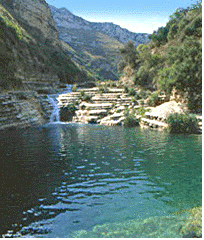...Best of Sicily presents... Best of Sicily Magazine. ... Dedicated to Sicilian art, culture, history, people, places and all things Sicilian. |
by Vincenzo Mormino | |||
Magazine Index Best of Sicily Arts & Culture Fashion Food & Wine History & Society About Us Travel Faqs Contact Map of Sicily
|
Unlike Alcantara, which was formed of dark basalt by volcanic activity, Cavagrande's evolution was slow even by geologic standards. Here, as throughout most of Sicily, Calabria and Malta, the bedrock consists primarily of golden limestone. It is into this stone that the canyon was carved over time. The Cassibile River (historically sometimes called the "Cassabile") was known to the ancient Greeks as the Kacyparis, and the few necropoli carved into its walls, while they do not rival those of Pantalica, indicate habitation of the area in antiquity. Long before the arrival of the Greeks, the Sikels had two small settlements here circa 1200 BC (BCE). In the carved homes and tombs there are traces of Ausonian architectural influences. Like the Alcantara Valley, the Cassibile is a footnote to military history. In 413 BC the Ionian mouth of the Cassibile River was the site of the surrender, to Siracusan forces, of six thousand Athenian troops who had been led by the defeated Demosthenes. Their leader was exceuted and most of the Athenians were enslaved. The canyon, which is a protected nature reserve, is home to a number of animal species, including the Sicilian Rock Partridge, the Mediterranean peregrine falcon (Falco peregrinus) and a local variety of the long-tailed tit (Aegithalos caudatus siculus). These birds are not alone. The hedgehog and Hermann's tortoise live here. Surprisingly, so does the European pine marten (Martes martes), preyed upon by the equally rare red fox. The leopard snake (Zamenis situla) is at home in this rocky environment. A particularly rare species, the freshwater crab (Potamon fluviatile), lives here, and so does the distinctively green Italian Tree Frog (Hyla intermedia). Over four hundred native plant species - some quite rare in Sicily - are found in the Cassibile Valley. Here we'll mention a few. Several orchid species thrive in the canyon. The Sicilian orchid (Ophrys lunulata), identified by botanist Filippo Parlatore in 1838, is a purplish flower on the endangered list. The more delicate Anacamptis longicornu is also present. The rare but more widely diffused Ophrys exaltata is found as far away as Spain. The Sicilian snapdragon (Antirrhinum siculum) blooms in Spring; it is also found on Malta and Gozo. The wild snowdrop (Galanthus nivalis) grows here, as do the the pot marigold (Calendula suffruticosa), the wood splurge (Euphorbia amygdaloides), ladder brake fern (Pteris vittata pteris), tree germander (Teucrium fruticans), the deep blue Sicilian throatwort (Trachelium lanceolatum), horsetail (Equisetum arvense) and others. Myrtle, sage (the salvia plant), rosemary, lesser calamint (non-edible Calamintha nepeta), oregano and thyme are abundant. All in all, a priceless gift from Nature. About the Author: Vincenzo Mormino has written about wildlife and nature for Best of Sicily and hard-copy publications. | ||
Top of Page |
 It is
not Sicily's only canyon (there are several others, including
It is
not Sicily's only canyon (there are several others, including